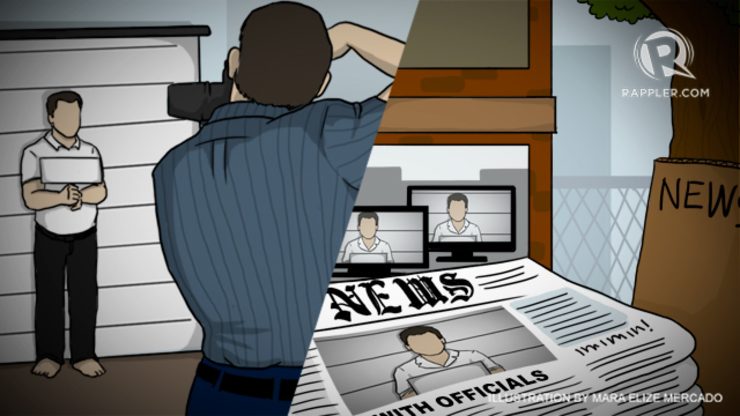SUMMARY
This is AI generated summarization, which may have errors. For context, always refer to the full article.

MANILA, Philippines – The public has seen it: mugshots of alleged pork barrel scam senators Ramon “Bong” Revilla Jr and Jinggoy Estrada, as well as alleged scam mastermind Janet Lim Napoles.
In the past, the nation also got to see the mugshots of former presidents Joseph Estrada and Gloria Macapagal-Arroyo, as well as other arrested suspects in highly-publicized cases.
But what is really the rule on the release of mugshots to the media? And does its publication invade the right to privacy of the arrested person?
Chief Superintendent Reuben Theodore Sindac, spokesperson of the Philippine National Police (PNP), admitted that they have no clear-cut policy on it. (READ: Unclear rule leads to Jinggoy mugshot leak)
“We are aware that there are people looking for the mugshot. But it is not our obligation to release it,” Sindac told Rappler.
“But, as in any other public document, the release of the information is subject to the authority that will release it. If the [PNP Criminal Investigation and Detection Group] gives us [PNP Public Information Office] clearance to release it, then we would release it,” he added.
The mugshots taken by the police during the booking procedures are submitted to the court that has jurisdiction over the case. The photos are requirements in an accused’s return of warrant of arrest before the court releases its order assigning his jail.
The PNP’s Standard Operating Procedures (SOP) on the Booking of Arrested Suspects states, “In high profile cases, mugshots may also be published by the media.” The SOP, however, did not mention where the media could obtain a copy of the mugshots nor what procedures to follow when requesting for it.
In the United States, the release of mugshots to the media or the public are generally not made because “it would not serve law enforcement purposes,” according to a 2012 memorandum by the Marshals Service of the US Department of Justice.
As a special case, the mugshots of arrested fugitives may be published “for the purpose of informing the public that a particularly notorious fugitive… has been apprehended” or captured.
Media leaks
There have been instances in the Philippines when either the accused, the police, or the courts withheld the release of mugshots. But, as in previous high-profile cases, the media got hold of it one way or the other.
In the case of the two arrested senators implicated in the pork barrel scam, their mugshots were submitted to the anti-graft court Sandiganbayan. (READ: Napoles, 3 senators indicted for plunder)
The PNP, instead of releasing their mugshots to the media, chose to release photos of Revilla going through booking procedures and Estrada’s surrender to his father, Manila Mayor Joseph Estrada.
But their mugshots were leaked to the media, with GMA News publishing Estrada’s photo and ABS-CBN News tweeting a photo of regular-sized bond paper bearing Revilla’s mugshots.
The same mugshot leak took place in November 2011, when former president Gloria Macapagal-Arroyo was arrested due to an electoral sabotage case filed against her.
Pasay City Regional Trial Court Branch 112 Judge Jesus Mupas granted the request of the Arroyo camp to not allow the release of her mugshot, saying that it is based on the “right and interest of the accused.”
Parties who want to see or get copies of her mugshots should file a motion for release, the court said. However, her mugshots were uploaded online at mugshots.com.
The Philippine Daily Inquirer obtained a copy of the pictures, and published it on the newspaper’s front page.
The government said that these photos were fake, but a police chief confirmed its authenticity. (READ: GMA “mugshots”: real or not?)
Public interest vs defendant’s privacy
Shortly after the publication of Arroyo’s mugshots, Senator Miriam Defensor-Santiago weighed in on the matter on her blog. She said that the publication of mugshots violates the right to privacy of the accused.
Santiago cited cases in the United States where the courts favored the privacy of the suspects over the public’s interest in their cases.
“The accused has a substantial personal privacy interest in preventing public dissemination of his or her non-public booking photographs.
“On the other hand, the public obtains no discernable interest from viewing the booking photographs, except perhaps the negligible value of satisfying voyeuristic curiosities.”
However, an often-cited case in this debate states that the release of mugshots of indicted criminal defendants does not constitute an invasion of their privacy.
The US Court of Appeals, in its decision on the 1996 Detroit Free Press vs. Department of Justice case, noted that the names of indicted suspects have already been made public and the arrestees have already made court appearances.
The court tackled disclosures of mugshots only in ongoing criminal proceedings and media requests for it under the US Freedom of Information Act (FOIA). – Rappler.com
What do you think should prevail, your interest or the defendant’s right to privacy? Sound off in the comments section below.
Add a comment
How does this make you feel?
There are no comments yet. Add your comment to start the conversation.